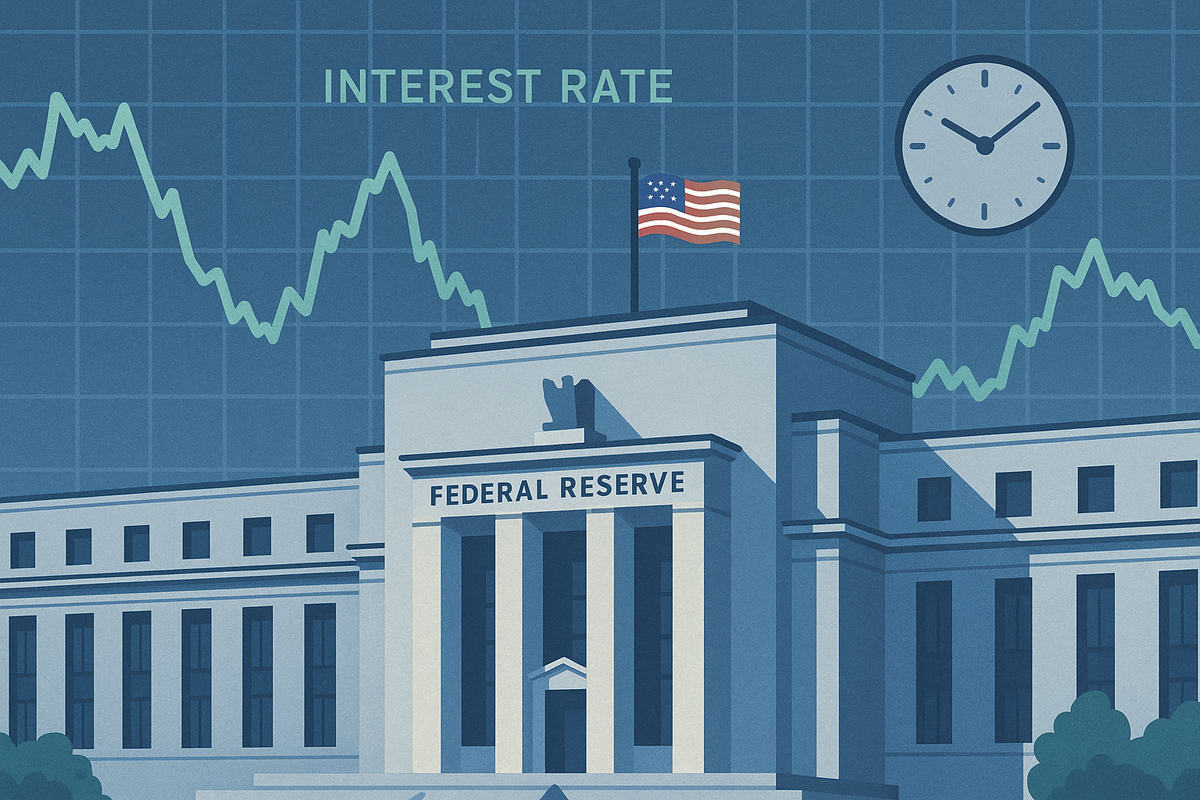
Investor sentiment is overwhelmingly pointing towards a significant shift in the Federal Reserve's monetary policy, with a near-certainty of a 25-basis-point interest rate cut anticipated at its September meeting. This widespread expectation, currently hovering around a 92% probability, is sending ripples through financial markets, influencing everything from stock valuations to mortgage rates. All eyes are now firmly fixed on Federal Reserve Chair Jerome Powell's upcoming speech at the highly anticipated Jackson Hole Symposium, where market participants will be scrutinizing every word for further clues regarding the central bank's future trajectory. The implications of such a move are profound, signaling a potential easing of financial conditions and a recalibration of investment strategies across the board.
The Impending Shift: Why a September Rate Cut Matters
The financial world is abuzz with the strong likelihood of a 25-basis-point reduction in the federal funds rate in September, which would lower the benchmark rate from its current 4.25%-4.50% target range to 4.00%-4.25%. This expectation has been consistently high, with probabilities ranging from 92.1% to 94.3% according to various market indicators. While there have been minor fluctuations following stronger-than-expected Producer Price Index (PPI) and resilient Retail Sales data, the overwhelming consensus remains firmly in favor of a September cut.
This anticipation is primarily driven by emerging evidence of easing inflationary pressures and a stabilizing, albeit somewhat softening, economic environment. The Federal Reserve faces the delicate task of balancing its dual mandate: controlling inflation while simultaneously fostering sustainable economic growth. Recent economic indicators, particularly a disappointing July payroll report and downward revisions to previous jobs data, have suggested a potential weakening in the labor market. This softening, coupled with signs of disinflation, has further bolstered the argument for a pre-emptive rate cut aimed at sustaining economic expansion or normalizing policy in a non-recessionary environment. The market's immediate reaction has been a general boost to risk assets, as cheaper borrowing costs typically encourage greater investment and a higher appetite for growth-oriented sectors.
Winners and Losers in a Lower Rate Environment
A Federal Reserve interest rate cut, while generally aimed at stimulating economic activity, creates a distinct landscape of winners and losers across various sectors and public companies. The primary mechanism is the reduction in borrowing costs, which can lead to increased consumer spending, higher corporate profits, and a potential rise in stock prices.
The Beneficiaries:
The Real Estate sector stands to be a significant winner. Lower interest rates directly translate to more affordable mortgage rates, stimulating demand for housing. Homebuilders and building products companies, such as Lowe's (NYSE: LOW) and Target (NYSE: TGT), are expected to see increased sales. Real Estate Investment Trusts (REITs) like American Tower (NYSE: AMT) and Prologis (NYSE: PLG) also benefit from reduced borrowing costs, improving the economics of property deals and allowing for portfolio expansion.
Consumer Discretionary companies are also poised for gains. With lower borrowing costs on credit cards and auto loans, consumers have more disposable income, encouraging spending on non-essential goods and services. This could boost sales for retailers and auto manufacturers like Tesla (NASDAQ: TSLA) and Nissan Motors (TYO: 7201). Even restaurant chains, such as those operated by Brinker International (NYSE: EAT), have shown positive results in an environment of anticipated rate cuts.
The Technology sector, particularly growth-stage firms, often thrives in a lower-rate environment. Their valuations are heavily based on future earnings potential, and lower interest rates reduce the "discount rate" used in valuation models, making those future cash flows more valuable. Cheaper borrowing costs are also crucial for capital-intensive tech companies to fund innovation and expansion. While large tech giants like Nvidia (NASDAQ: NVDA) and Apple (NASDAQ: AAPL) have driven market trends, lower rates could also diversify investment, benefiting biotech stocks like Bio-Techne (NASDAQ: TECH) and Solid Biosciences (NASDAQ: SLDB).
Utilities and companies with significant debt loads are also likely to benefit. Utilities, often considered dividend-paying industries, become more appealing to investors seeking income as bond yields fall. They also benefit from cheaper financing for their capital-intensive infrastructure projects. Companies like Constellation Energy (NASDAQ: CEG) and FirstEnergy (NYSE: FE) could see improved financial health. Similarly, companies with substantial debt, such as AbbVie (NYSE: ABBV) and Verizon Communications (NYSE: VZ), will see reduced interest expenses, freeing up capital for investment or stock buybacks.
The Potential Underperformers:
While banks generally benefit from increased lending volume, lower rates can compress their net interest margins on new loans, potentially impacting profitability if not offset by a significant increase in loan origination. Companies that hold significant amounts of cash or whose revenue models are heavily dependent on prevailing interest rates may also see reduced profits as yields on cash-like securities decrease.
Furthermore, sectors or companies that have already experienced significant stock price appreciation in anticipation of rate cuts might not see much further upside, as the positive news could already be "priced in" by the market. Historically, the technology sector has sometimes underperformed immediately after rate cuts, despite long-term benefits. Defensive sectors like Consumer Staples and Healthcare, while resilient during economic downturns, may lose some appeal as the market rebounds and investors pivot towards more cyclical sectors to capture growth opportunities.
Industry Impact and Broader Implications
The anticipated Federal Reserve rate cut is not an isolated event; it fits into a broader narrative of central banks globally navigating a complex economic landscape marked by persistent inflation, evolving labor markets, and geopolitical uncertainties. This move by the Fed could trigger a ripple effect across international markets, influencing currency valuations, capital flows, and the monetary policy decisions of other central banks.
One significant implication is the potential for increased merger and acquisition (M&A) activity. A lower cost of capital makes it cheaper for companies to borrow funds for acquisitions, potentially leading to a surge in consolidation across various industries. This could impact competitors and partners, as market structures shift and new dominant players emerge. For instance, smaller, innovative companies might become attractive targets for larger corporations seeking to expand their market share or acquire new technologies.
From a regulatory and policy standpoint, a rate cut could signal a more accommodative stance from the Fed, potentially easing pressure on fiscal policy. Governments might find it easier to finance debt at lower interest rates, providing more flexibility for public spending and infrastructure projects. However, there's also the risk that overly loose monetary policy could reignite inflationary pressures down the line, prompting future policy adjustments.
Historically, periods of Federal Reserve rate cuts in non-recessionary environments have often been associated with robust stock market performance, particularly for the S&P 500 (INDEXSP: .INX). This suggests that the current anticipated cut, if aimed at sustaining economic expansion rather than combating a severe downturn, could provide a tailwind for equities. However, the market's sensitivity to any signals that might contradict the expectation of a rate cut remains high. Unexpected hawkish remarks from Federal Reserve officials or stronger-than-anticipated economic data could trigger significant market volatility, underscoring the delicate balance the Fed must maintain in its communication and policy implementation.
What Comes Next
The immediate aftermath of a Federal Reserve interest rate cut, particularly one signaled or confirmed by Federal Reserve Chair Jerome Powell at the Jackson Hole Symposium, will set the tone for financial markets in the short and long term. Powell's address at Jackson Hole is often a pivotal moment for signaling major shifts in monetary policy, making his words highly scrutinized.
In the short term, a stock market rally is a strong possibility. Lower borrowing costs for companies can boost corporate profitability, making it cheaper to finance operations and invest in growth initiatives. This often prompts investors to shift from lower-yielding bonds to equities, driving stock prices higher. Historically, the S&P 500 (INDEXSP: .INX) has seen positive returns in the 12 months following an initial rate cut in 86% of cycles since 1929, with an average return of 15% since 1974 when not in a recession. Consumers may also see a reduction in interest rates on various loans, including credit cards and auto loans, potentially offering opportunities for refinancing. Conversely, savers might experience reduced returns on savings accounts and certificates of deposit (CDs). A dovish signal from Powell or an actual rate cut could also lead to a weakening of the U.S. dollar against other major currencies, making dollar-denominated assets less attractive to foreign investors.
Looking further ahead, the long-term implications are aimed at stimulating broader economic activity. Lower interest rates are intended to encourage borrowing and investment by businesses and consumers, leading to increased spending, job creation, and overall economic growth. However, there's a delicate balance to strike; if lower rates stimulate the economy too much, inflationary pressures could resurface, eroding consumer purchasing power. The Fed's challenge will be to support growth without reigniting inflation. Sustained low rates could also encourage excessive borrowing, potentially leading to increased household and corporate debt levels.
Market opportunities may emerge in specific sectors. Growth stocks, particularly in technology and communication services, could benefit from lower financing costs. The real estate sector, including homebuilders and REITs, could see increased demand due to lower mortgage rates. Small-cap stocks, often more sensitive to domestic economic conditions and borrowing costs, tend to perform well in lower-rate environments. Gold and other precious metals might also rally if the Fed's signals are dovish, indicating easier monetary policy and potential inflation. The future trajectory will heavily depend on the Fed's subsequent communication and incoming economic data, with scenarios ranging from a sustained market rally if Powell confirms a dovish path, to market volatility if he adopts a more cautious or "hawkish" stance.
Conclusion
The impending Federal Reserve interest rate cut in September, with its high probability, marks a significant turning point in monetary policy. This move, coupled with the highly anticipated speech from Federal Reserve Chair Jerome Powell at the Jackson Hole Symposium, underscores the central bank's efforts to navigate a complex economic landscape characterized by easing inflation and a softening labor market. The immediate implications are already being felt across financial markets, with a general boost to risk assets and a recalibration of investor expectations.
The key takeaway from this event is the Federal Reserve's commitment to supporting economic expansion, even as it remains vigilant against inflationary pressures. The potential winners from this policy shift include sectors like real estate, consumer discretionary, and technology, which stand to benefit from lower borrowing costs and increased consumer spending. Conversely, some financial institutions and cash-heavy companies might face challenges due to compressed margins or reduced returns on their holdings.
Moving forward, investors should closely monitor the Federal Reserve's subsequent communications and incoming economic data, particularly inflation figures and employment reports. The market's sensitivity to any deviation from the expected dovish stance remains high, and unexpected hawkish remarks or stronger-than-anticipated economic data could trigger significant volatility. The long-term impact will depend on whether the rate cut successfully stimulates sustainable economic growth without reigniting inflation. The coming months will reveal the true extent of this policy shift's influence on corporate earnings, consumer behavior, and the broader economic trajectory.






